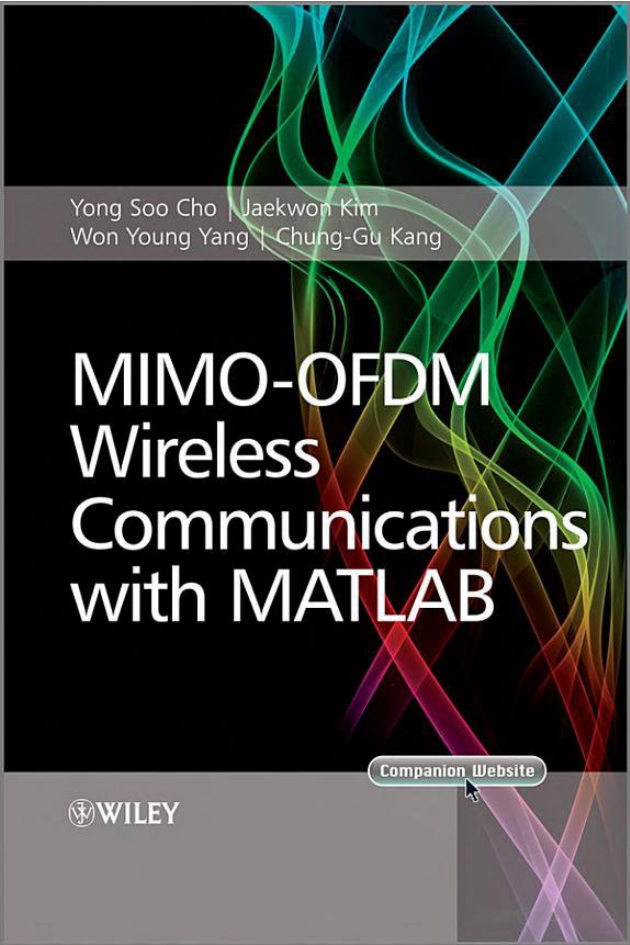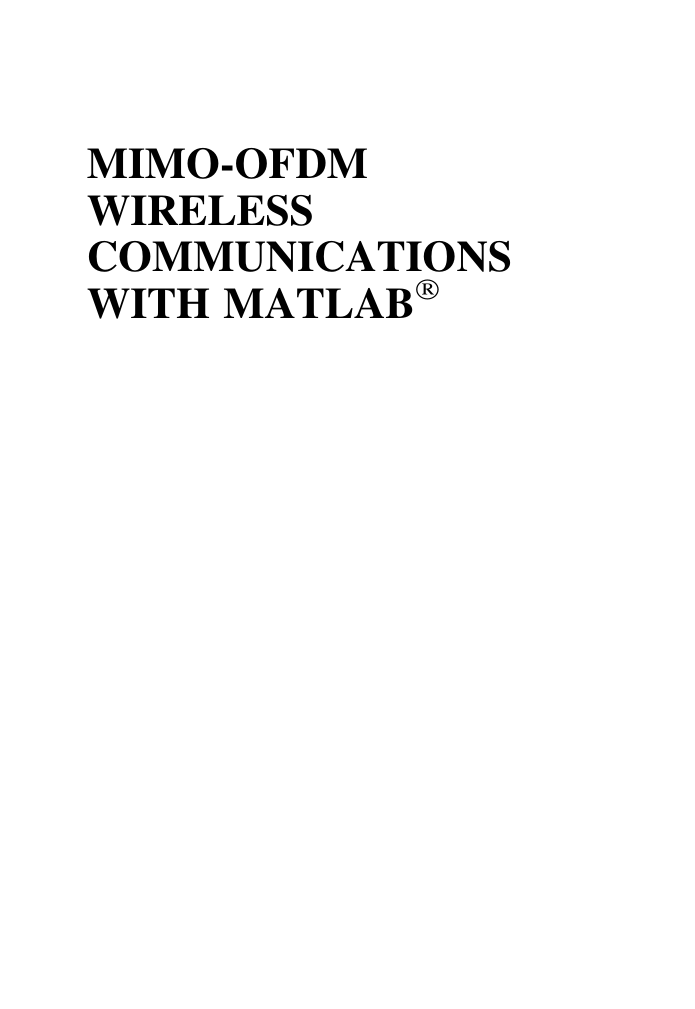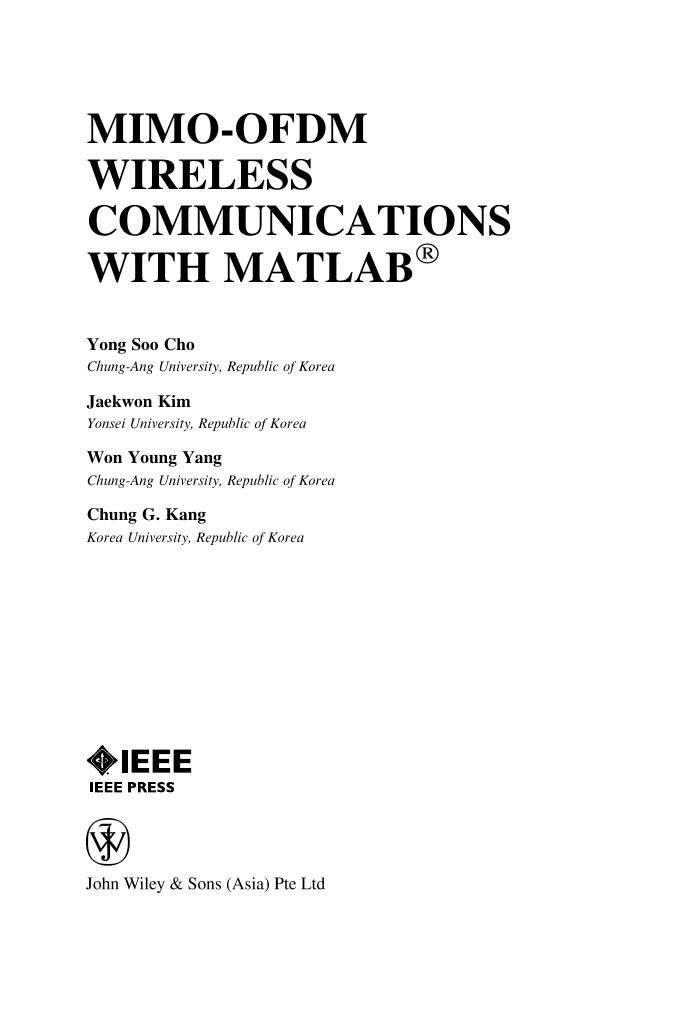MIMO-OFDM Wireless Communications with MATLAB®
Contents
Preface
Limits of Liability and Disclaimer of Warranty of Software
1 The Wireless Channel: Propagation and Fading
1.1 Large-Scale Fading
1.1.1 General Path Loss Model
1.1.2 Okumura/Hata Model
1.1.3 IEEE 802.16d Model
1.2 Small-Scale Fading
1.2.1 Parameters for Small-Scale Fading
1.2.2 Time-Dispersive vs. Frequency-Dispersive Fading
1.2.3 Statistical Characterization and Generation of Fading Channel
2 SISO Channel Models
2.1 Indoor Channel Models
2.1.1 General Indoor Channel Models
2.1.2 IEEE 802.11 Channel Model
2.1.3 Saleh-Valenzuela (S-V) Channel Model
2.1.4 UWB Channel Model
2.2 Outdoor Channel Models
2.2.1 FWGN Model
2.2.2 Jakes Model
2.2.3 Ray-Based Channel Model
2.2.4 Frequency-Selective Fading Channel Model
2.2.5 SUI Channel Model
3 MIMO Channel Models
3.1 Statistical MIMO Model
3.1.1 Spatial Correlation
3.1.2 PAS Model
3.2 I-METRA MIMO Channel Model
3.2.1 Statistical Model of Correlated MIMO Fading Channel
3.2.2 Generation of Correlated MIMO Channel Coefficients
3.2.3 I-METRA MIMO Channel Model
3.2.4 3GPP MIMO Channel Model
3.3 SCM MIMO Channel Model
3.3.1 SCM Link-Level Channel Parameters
3.3.2 SCM Link-Level Channel Modeling
3.3.3 Spatial Correlation of Ray-Based Channel Model
4 Introduction to OFDM
4.1 Single-Carrier vs. Multi-Carrier Transmission
4.1.1 Single-Carrier Transmission
4.1.2 Multi-Carrier Transmission
4.1.3 Single-Carrier vs. Multi-Carrier Transmission
4.2 Basic Principle of OFDM
4.2.1 OFDM Modulation and Demodulation
4.2.2 OFDM Guard Interval
4.2.3 OFDM Guard Band
4.2.4 BER of OFDM Scheme
4.2.5 Water-Filling Algorithm for Frequency-Domain Link Adaptation
4.3 Coded OFDM
4.4 OFDMA: Multiple Access Extensions of OFDM
4.4.1 Resource Allocation – Subchannel Allocation Types
4.4.2 Resource Allocation – Subchannelization
4.5 Duplexing
5 Synchronization for OFDM
5.1 Effect of STO
5.2 Effect of CFO
5.2.1 Effect of Integer Carrier Frequency Offset (IFO)
5.2.2 Effect of Fractional Carrier Frequency Offset (FFO)
5.3 Estimation Techniques for STO
5.3.1 Time-Domain Estimation Techniques for STO
5.3.2 Frequency-Domain Estimation Techniques for STO
5.4 Estimation Techniques for CFO
5.4.1 Time-Domain Estimation Techniques for CFO
5.4.2 Frequency-Domain Estimation Techniques for CFO
5.5 Effect of Sampling Clock Offset
5.5.1 Effect of Phase Offset in Sampling Clocks
5.5.2 Effect of Frequency Offset in Sampling Clocks
5.6 Compensation for Sampling Clock Offset
5.7 Synchronization in Cellular Systems
5.7.1 Downlink Synchronization
5.7.2 Uplink Synchronization
6 Channel Estimation
6.1 Pilot Structure
6.1.1 Block Type
6.1.2 Comb Type
6.1.3 Lattice Type
6.2 Training Symbol-Based Channel Estimation
6.2.1 LS Channel Estimation
6.2.2 MMSE Channel Estimation
6.3 DFT-Based Channel Estimation
6.4 Decision-Directed Channel Estimation
6.5 Advanced Channel Estimation Techniques
6.5.1 Channel Estimation Using a Superimposed Signal
6.5.2 Channel Estimation in Fast Time-Varying Channels
6.5.3 EM Algorithm-Based Channel Estimation
6.5.4 Blind Channel Estimation
7 PAPR Reduction
7.1 Introduction to PAPR
7.1.1 Definition of PAPR
7.1.2 Distribution of OFDM Signal
7.1.3 PAPR and Oversampling
7.1.4 Clipping and SQNR
7.2 PAPR Reduction Techniques
7.2.1 Clipping and Filtering
7.2.2 PAPR Reduction Code
7.2.3 Selective Mapping
7.2.4 Partial Transmit Sequence
7.2.5 Tone Reservation
7.2.6 Tone Injection
7.2.7 DFT Spreading
8 Inter-Cell Interference Mitigation Techniques
8.1 Inter-Cell Interference Coordination Technique
8.1.1 Fractional Frequency Reuse
8.1.2 Soft Frequency Reuse
8.1.3 Flexible Fractional Frequency Reuse
8.1.4 Dynamic Channel Allocation
8.2 Inter-Cell Interference Randomization Technique
8.2.1 Cell-Specific Scrambling
8.2.2 Cell-Specific Interleaving
8.2.3 Frequency-Hopping OFDMA
8.2.4 Random Subcarrier Allocation
8.3 Inter-Cell Interference Cancellation Technique
8.3.1 Interference Rejection Combining Technique
8.3.2 IDMA Multiuser Detection
9 MIMO: Channel Capacity
9.1 Useful Matrix Theory
9.2 Deterministic MIMO Channel Capacity
9.2.1 Channel Capacity when CSI is Known to the Transmitter Side
9.2.2 Channel Capacity when CSI is Not Available at the Transmitter Side
9.2.3 Channel Capacity of SIMO and MISO Channels
9.3 Channel Capacity of Random MIMO Channels
10 Antenna Diversity and Space-Time Coding Techniques
10.1 Antenna Diversity
10.1.1 Receive Diversity
10.1.2 Transmit Diversity
10.2 Space-Time Coding (STC): Overview
10.2.1 System Model
10.2.2 Pairwise Error Probability
10.2.3 Space-Time Code Design
10.3 Space-Time Block Code (STBC)
10.3.1 Alamouti Space-Time Code
10.3.2 Generalization of Space-Time Block Coding
10.3.3 Decoding for Space-Time Block Codes
10.3.4 Space-Time Trellis Code
11 Signal Detection for Spatially Multiplexed MIMO Systems
11.1 Linear Signal Detection
11.1.1 ZF Signal Detection
11.1.2 MMSE Signal Detection
11.2 OSIC Signal Detection
11.3 ML Signal Detection
11.4 Sphere Decoding Method
11.5 QRM-MLD Method
11.6 Lattice Reduction-Aided Detection
11.6.1 Lenstra-Lenstra-Lovasz (LLL) Algorithm
11.6.2 Application of Lattice Reduction
11.7 Soft Decision for MIMO Systems
11.7.1 Log-Likelihood-Ratio (LLR) for SISO Systems
11.7.2 LLR for Linear Detector-Based MIMO System
11.7.3 LLR for MIMO System with a Candidate Vector Set
11.7.4 LLR for MIMO System Using a Limited Candidate Vector Set
Appendix 11.A Derivation of Equation (11.23)
12 Exploiting Channel State Information at the Transmitter Side
12.1 Channel Estimation on the Transmitter Side
12.1.1 Using Channel Reciprocity
12.1.2 CSI Feedback
12.2 Precoded OSTBC
12.3 Precoded Spatial-Multiplexing System
12.4 Antenna Selection Techniques
12.4.1 Optimum Antenna Selection Technique
12.4.2 Complexity-Reduced Antenna Selection
12.4.3 Antenna Selection for OSTBC
13 Multi-User MIMO
13.1 Mathematical Model for Multi-User MIMO System
13.2 Channel Capacity of Multi-User MIMO System
13.2.1 Capacity of MAC
13.2.2 Capacity of BC
13.3 Transmission Methods for Broadcast Channel
13.3.1 Channel Inversion
13.3.2 Block Diagonalization
13.3.3 Dirty Paper Coding (DPC)
13.3.4 Tomlinson-Harashima Precoding
References
Index
















 2023年江西萍乡中考道德与法治真题及答案.doc
2023年江西萍乡中考道德与法治真题及答案.doc 2012年重庆南川中考生物真题及答案.doc
2012年重庆南川中考生物真题及答案.doc 2013年江西师范大学地理学综合及文艺理论基础考研真题.doc
2013年江西师范大学地理学综合及文艺理论基础考研真题.doc 2020年四川甘孜小升初语文真题及答案I卷.doc
2020年四川甘孜小升初语文真题及答案I卷.doc 2020年注册岩土工程师专业基础考试真题及答案.doc
2020年注册岩土工程师专业基础考试真题及答案.doc 2023-2024学年福建省厦门市九年级上学期数学月考试题及答案.doc
2023-2024学年福建省厦门市九年级上学期数学月考试题及答案.doc 2021-2022学年辽宁省沈阳市大东区九年级上学期语文期末试题及答案.doc
2021-2022学年辽宁省沈阳市大东区九年级上学期语文期末试题及答案.doc 2022-2023学年北京东城区初三第一学期物理期末试卷及答案.doc
2022-2023学年北京东城区初三第一学期物理期末试卷及答案.doc 2018上半年江西教师资格初中地理学科知识与教学能力真题及答案.doc
2018上半年江西教师资格初中地理学科知识与教学能力真题及答案.doc 2012年河北国家公务员申论考试真题及答案-省级.doc
2012年河北国家公务员申论考试真题及答案-省级.doc 2020-2021学年江苏省扬州市江都区邵樊片九年级上学期数学第一次质量检测试题及答案.doc
2020-2021学年江苏省扬州市江都区邵樊片九年级上学期数学第一次质量检测试题及答案.doc 2022下半年黑龙江教师资格证中学综合素质真题及答案.doc
2022下半年黑龙江教师资格证中学综合素质真题及答案.doc